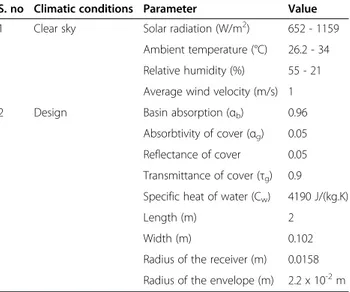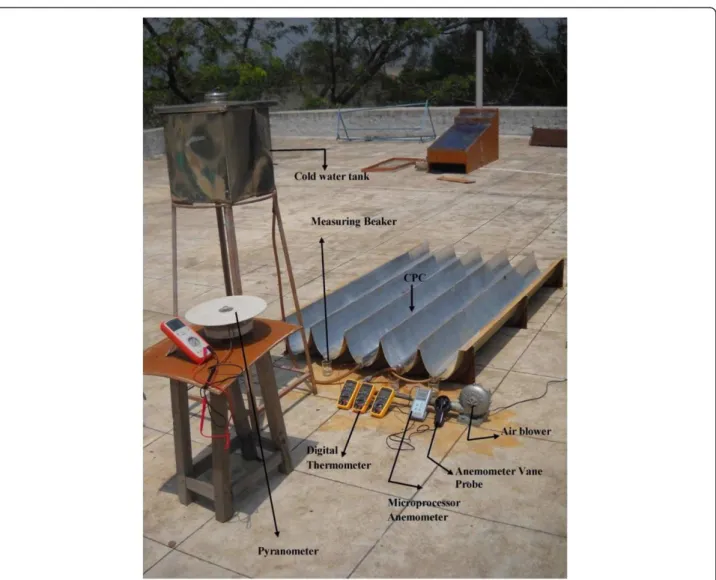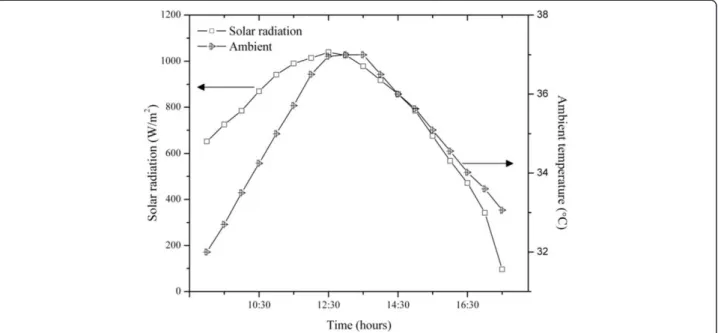T E C H N I C A L N O T E
Open Access
Effect of air flow on tubular solar still efficiency
Arunkumar Thirugnanasambantham
1*ˆ
, Jayaprakash Rajan
2ˆ
, Amimul Ahsan
2and Vinothkumar Kandasamy
3ˆ
Abstract
Background:An experimental work was reported to estimate the increase in distillate yield for a compound parabolic concentrator-concentric tubular solar still (CPC-CTSS). The CPC dramatically increases the heating of the saline water. A novel idea was proposed to study the characteristic features of CPC for desalination to produce a large quantity of distillate yield. A rectangular basin of dimension 2 m × 0.025 m × 0.02 m was fabricated of copper and was placed at the focus of the CPC. This basin is covered by two cylindrical glass tubes of length 2 m with two different diameters of 0.02 m and 0.03 m. The experimental study was operated with two modes: without and with air flow between inner and outer tubes. The rate of air flow was fixed throughout the experiment at 4.5 m/s. On the basis of performance results, the water collection rate was 1445 ml/day without air flow and 2020 ml/day with air flow and the efficiencies were 16.2% and 18.9%, respectively.
Findings:The experimental study was operated with two modes: without and with air flow between inner and outer tubes. The rate of air flow was fixed throughout the experiment at 4.5 m/s.
Conclusions:On the basis of performance results, the water collection rate was 1445 ml/day without air flow and 2020 ml/day with air flow and the efficiencies were 16.2% and 18.9%, respectively.
Keywords:Compound Parabolic Concentrator, Desalination, Tubular Solar Still
Introduction
Ahsan and Fukuhara [1] studied on a new heat and mass transfer tubular solar still and found that the heat and mass transfer coefficients can be expressed as functions of the temperature difference between the saline water and the cover. Ahsan et al. [2], experimentally studied on the evaporation, condensation and production of a tubular solar still and found that the relative humidity of the humid air was definitely not saturated and the hourly evaporation, condensation and production fluxes were proportional to the humid air temperature and relative humidity. Ahsan and Fukuhara [3-5] analyzed on a tubular solar still and on a quasi steady heat and mass transfer due to evaporation and condensation taking an account of humid air properties inside the still and found that the analytical solutions derived from the present model could reproduce the experimental results perfectly. Arunkumaret al. [6], studied on a hemispher-ical solar still.
Numerous research activities have been done with CPCs such as cost-effective asymmetric CPCs [7], non-modified absorbers [8], solar powered adsorption re-frigerator with CPC collection system [9], non-imaging solar collector [10], non-tracking solar concentrators [11], and non-evacuated solar collectors [12].
Singh et al. [13], studied on the design parameters for concentrator assisted solar distillation system. Analytical expressions for the water and glass cover temperatures, the rate of heat flux due to evaporation, the rate of dis-tillate output and the instantaneous thermal efficiency have been derived in terms of the system design and climatic parameters. It is analytically shown that the effi-ciency of the system with a concentrator was higher than that with a collector.
Chaochi et al. [14], designed and built a small solar desalination unit equipped with a parabolic concentrator and observed that the maximum efficiency corresponds to the maximum solar lighting obtained towards 14:00. At that hour, the boiler was nearly in a horizontal pos-ition, which maximizes the offered heat transfer surface. Mohamad and El-Minshawy [15] dealed with the status of solar energy as clean and renewable energy applica-tions in desalination.
* Correspondence:tarunkumarsolar@gmail.com ˆDeceased
1Department of Physics, Dr. NGP Institute of Technology, Coimbatore 641 048 Tamilnadu, India
Full list of author information is available at the end of the article
A novel idea proposed in this work is the CPC’s ab-sorber which is acting as a saline water basin in a tubu-lar arrangement. This specially designed CPC-CTSS required only 3 minutes warming up, as opposed to a typical warm-up period of an hour or more for basin type stills with no reflectors. The inner tube was cooled by flowing air at the rate of 4.5 m/s.
Design of the CPC
The reflector profile for the CPC [16] with a ‘V’groove at the bottom is such that all rays entering the cavity opening end up at the absorber. It can be drawn for a tubular absorber of radius r1, and half acceptance angle
θAallowing a small spaceδ between cavity opening and
the absorber see Figure 1.
x¼r1sinθ−ρcosθ ð1Þ
The upper portion of the reflector profile AB and CD can be generated using the relation,
x¼−r1cosθ−ρsinθ ð2Þ
Where;
ρis the ground reflectance:
ρ¼r1½θþΔθ ð3Þ
For the angles of
π−ð2φþεÞ≤θ≤θAþπ=2
ρ¼r1½θþθAþπ=2þ2Δθ−cosðθ−θAÞ
1þ sinðθ−θAÞ
½ ð4Þ
For the range of angles:
π=2þθA≤θ≤3π=2−θA
Where;
Δθ¼ cotφ−½π−ð2φþεÞ ð5Þ
And, from the Figure 1:
φ¼sin−1ðr1=r2Þ ð6Þ φþε¼ sin−1½ðr1þδÞ=r2 ð7Þ
The upper portion of the radius of envelope is:
r2¼ r1
2þðδ=2 sinαÞ2þ
δr1
1=2
cosα ð8Þ
1=sinα
ð Þ−sinα¼δ=2r1 ð9Þ
The bottom region of the profile can be modified by incorporating a V-shaped reflector portion just below the absorber.
The height ‘h’ and the open angle ‘2Ψ’ of the ‘V’
groove are related by the following relations:
π−2α≤2ψ≤π=2þα ð10Þ
sinα¼r1=ðrþδþhÞ ð11Þ
Average fraction of radiation lost‘L’is given by:
L≈ ε
2
2 1ð þ2φtanφÞ ð12Þ
Figure 1Reflector shape for tubular absorber.
Table 1 Still technical and operation details
S. no Climatic conditions Parameter Value
1 Clear sky Solar radiation (W/m2) 652 - 1159
Ambient temperature (°C) 26.2 - 34
Relative humidity (%) 55 - 21
Average wind velocity (m/s) 1
2 Design Basin absorption (αb) 0.96
Absorbtivity of cover (αg) 0.05
Reflectance of cover 0.05
Transmittance of cover (τg) 0.9
Specific heat of water (Cw) 4190 J/(kg.K)
Length (m) 2
Width (m) 0.102
Radius of the receiver (m) 0.0158
And the ratio of the concentration achieved to the maximum possible concentration of the concentrator is calculated as:
CR
CRmax¼
cotφþ2φþε
π ð13Þ
Where;
CRmax¼1=sinθA ð14Þ
Materials and methods
A 2 m concentric tubular solar still was designed and fabricated. The specification of the tubular solar still is
shown in Table 1. The inner and outer tubes were positioned with a 5 mm gap for the flowing air to cool the outer surface of the inner tube. An air blower was used to propel the air inside the tube at constant rate of 4.5 m/s. A rectangular basin of dimension 2 m × 0.03 m × 0.025 m was designed and coated with black paint using a spray technique. The surface was free of dust, dirt, rust and moisture before spraying. During operation, the water level in the basin decreased due to fast evaporation from the basin, so a dry spot appeared in the basin. This was avoided in successive trials by flowing the water continuously in the still with the help of a graduated tube. This continuous supply of water was maintained by a water storage tank which was kept near to the CPC still. The outlet of the storage tank was connected to the inlet of the CPC still. After saline water was poured inside the basin, the entire arrangement was sealed properly by using a rubber cork to ensure no air leakage. The cooling air had a constant flow rate of 4.5 m/s. Microprocessor digital anemometer (AM 4201) with anemometer vane probe was used to measure the flow rate of air inside the concentric tubes. The flow meter was calibrated for the actual flow rate at the oper-ating temperature range. The process was repeated many times to assure a good accuracy and each time the flow rate were measured for a 1 minute interval.
The following parameters were measured every ten minutes: water temperature (Tw), interior humid air
temperature (Ta), ambient temperature (Tamb), total
diffuse solar radiation (I), and distillate yield. The diffuse radiation is measured by a precision Pyranometer. All dimensions of the pictorial and schematic views of the experimental device are shown in Figures 2, 3 and 4. Figure 2Cross sectional view of CPC-CTSS.
Water quality analysis
The water quality analysis is performed at the Tamilnadu Agricultural University’s, Soil Science and Agricultural Chemistry Department in Coimbatore, India. The results obtained are presented in Table 2. Two different water samples (A and B) are tested with their pH and electrical conductivity (in dS/m) measured before and after desa-lination. Before desalination, the level of electrical con-ductivity in the water of about 1 dS/m which is ~2% of ocean water, but not drinkable was obtained. However, after desalination it decreased to 0.10 dS/m-, which is
drinkable. The typical pH varies from one water sample to another as well as on the nature of the construction
materials used in the water distribution system. It is usu-ally in the range of 6.5 to 8.
Findings
Ahmed [17] has reported a continuous increase in output from a solar still with the increase in total solar radiation. Hourly variation of daily distillate output depends upon how the radiation is distributed throughout the day. The solar radiation and ambient temperature for a typical day are shown in Figure 5. The variation of ambient temperature was in the range of 24.7°C to 36.2°C and solar radiation received during the study was in the range of
362 W/m2 to 1038 W/m2. Figure 6 shows the time
Figure 4Pictorial view of air blower arrangement.
Table 2 Tested water quality results
Sample no.
TDS (mg/L) pH Conductivity (Ds/m)
Before desalination After desalination Before desalination After desalination Before desalination After desalination
Sample A-B 320 40 7.60 7.32 1 0.10
variation of temperature with air flow over the inner tube. The water temperature was in the range of 45.7°C to 89°C without air flow and 34°C to 79.1°C with air flow. Figure 7 shows the variation of distilled yield with respect to time. The water collection rate obtained was 1428 mL/day without flow of air and 2020 mL/day with air flow. A significant increase in distilled water production was observed in the concentric tubular solar still with air flow over the inner tube. The average daily solar direct and diffuse incident radiation without and with air flow were
7080 Wh/m2 and 6960 Wh/m2, respectively. The total aperture was 2.04 m2. With a heat of vaporization at boil-ing of 2260 J/g, the overall solar efficiencies without and with air flow were 16.2% and 18.9%, respectively.
Discussion
The driving force of the solar distillation technique is the difference between temperature of water in the still basin and the temperature of the cover (Tw-Tc) Arunkumar et al., [6]. The existence of such temperature difference Figure 5Variation of solar radiation and ambient temperature with respect to time.
ensures the continuation of the distillation process. Clearly, the tubular solar still with top cover air cooling is superior to the solar still without cooling. This increase of output is shown in Figure 7. The productivity of the hemispherical solar still is moderately improved by cooling the top cover. The variation of distilled yield is in the range of 17 ml to 113 ml for without cooling and 32 ml to 132 ml with
cooling. The daily average water productivity is increased from 1500 ml to 2200 ml for a fixed flow rate of 4.5 m/s of cold air fed. Figure 8 depicts the diurnal variation of efficiency with respect to time. The overall daily efficiency is calculated with the total radiation and total water output. The conventional still achieved 16.2%, and the cooling air system improved it to 18.9%. This implies that Figure 7Variation of yield with respect to time.
Figure 8Time variation of output cooling air.
the efficiency of the tubular solar still was improved by a factor of 1.25 due to the effect of air cooling. However, the advantage of the CPC is that the expensive still area is minimized and replaced with relatively inexpensive reflector. Therefore, the overall cost of distilled water should be lower.
The inlet and outlet temperatures [18] of the cooling air are shown in Figure 8. The extracted heat from the CPC-CTSS would allow further production of distilled water in a single slope solar still. With a 25°C rise and 4.5 m/s flow for 8 hours, the amount of heat was 140 Wh. With a 50% efficient single slope still, this could produce an additional 110 ml of distilled water, roughly 5% increase in output and efficiency. Air flow meter was kept near by the system to supply the cooling air. Its temperature was influenced by the ambient temperature and the solar radiation falling on it, which explains the variation in input temperature.
Conclusion
This research article summarized a new compound para-bolic concentric-tubular solar still (CPC-CTSS), which has been designed for and tested under the climatic conditions of Coimbatore, India. The effect of cooling air flowing over the condensation surface was studied. The daily yield of CPC-CTSS was found 1445 mL/day and 16.2% efficiency without air flow and 2020 mL/day and 18.9% efficiency with air flow at a constant flow rate of 4.5 m/s. To bound in a nutshell, this innovative approach of concentrator assisted tubular solar still with air flow augments the performance with enhanced rate of evaporation and condensation with safer operation procedures.
Competing interests
The authors declare that they have no competing interests.
Authors’contributions
Arunkumar Thirugnanasambantham carried out the experiments under the guidance of Jayaprakash Rajan. All authors read and approved the final manuscript.
Acknowledgements
This study has received funding from Indian Ministry of New and Renewable Energy (MNRE). NREF/TU/2010/001. The Authors are grateful to Professor Dr. S. Jayaraman, for providing facilities to carry out experimental work at the institute.
Author details
1Department of Physics, Dr. NGP Institute of Technology, Coimbatore 641 048 Tamilnadu, India.2Department of Physics, Sri Ramakrishna Mission Vidyalaya College of Arts and Science, Coimbatore 41 020, Tamilnadu, India. 3Research and Development (Renewable Energy), NSP Green Energy Technologies Pvt. Ltd. Chennai, Tamilnadu, India.
Received: 9 January 2013 Accepted: 13 January 2013 Published: 15 April 2013
References
1. Ahsan A, Fukuhara T:Evaporative mass transfer in tubular solar still. Journal of Hydro science and Hydraulic Engineering2008,26:15–25.
2. Ahsan A, Fukuhara T:Condensation mass transfer in unsaturated humid air inside tubular solar still.J Hydrosci Hydraul Eng2010,28:31–42. 3. Ahsan A, Fukuhara T:Mass and heat transfer model of tubular solar still.
Sol Energ2010,84:1147–1156.
4. Ahsan A, Islam KMS, Fukuhara T, Ghazali AH:Experimental study on evaporation, condensation and production of a new tubular solar still. Desalination2010,260:172–179.
5. Ahsan A, Imteaz M, Rahman A, Yusuf B, Fukuhara T:Design, fabrication and performance analysis of an improved solar still.Desalination2012,
292:105–112.
6. Arunkumar T, Jayaprakash R, Denkenberger D, Ahsan A, Okundamiya MS, Kumar S, Tanaka H, Aybar HS:An experimental study on a hemispherical solar still.Desalination2012,286:342–348.
7. Tripanagnostopoulos Y, Yianoulis P, Papaefthimiou M, Souliotis, Nousia T:
Cost effective asymmetric CPC solar collectors.Renew Energ1996,
16:628–631.
8. Khonkar HEI, Sayigh AAM:Optimization of the tubular absorber using a compound parabolic concentrator.Renew Energ1995,6:17–21. 9. Manuel IG, Luis RR:Solar powered absorption refrigerator with CPC
collection system: collector design and experimental test.Energ Convers Manage2007,48:2587–2594.
10. Baum HP, Gordon JM:Geometric characteristics of ideal non-imaging (CPC solar collectors with cylindrical absorber.Sol Energ1984,33:455–458. 11. Spirkl W, Ries H, Muschaweck J, Winston R:Non tracking solar
concentrators.Sol Energ1998,62:113–120.
12. Rabl A, O’gallagher J, Winston R:Design and test of non-evacuated solar collectors with compound parabolic concentrators.Sol Energ1980,
25:335–351.
13. Singh SK, Bhatnagar VP, Tiwari GN:Design parameters for concentrator assisted solar distillation system.Energ Convers Manage1996,37:247–252. 14. Chaochi B, Zrelli A, Gabsi S:Desalination of brackish water by means
parabolic solar concentrator.Desalination2007,217:118–126. 15. Mohamad AMI, El-Minshawy NA:Theoretical investigation of solar
humidification-dehumidification system using parabolic trough concentrator.Energ Convers Manage2011,52:3112–3119.
16. Oommen R, Jayaraman S:Development and performance analysis of compound parabolic solar concentrators with reduced gap losses:‘V’ groove reflector.Renew Energ2002,27:259–275.
17. Ahmed ST:Study of single effect solar still with an internal condenser. Int J Solar and Wind Tech1988,5:637–643.
18. Rabbani D, Hooshyar H:Application of flat plate solar collector for thermal disinfection of water effluents.Iran J Environ Health Sci Eng2011,
8:117–122.
Cite this article as:Thirugnanasambanthamet al.:Effect of air flow on tubular solar still efficiency.Iranian Journal of Environmental Health Sciences &
Engineering201310:31.
Submit your next manuscript to BioMed Central and take full advantage of:
• Convenient online submission
• Thorough peer review
• No space constraints or color figure charges
• Immediate publication on acceptance
• Inclusion in PubMed, CAS, Scopus and Google Scholar
• Research which is freely available for redistribution
Submit your manuscript at www.biomedcentral.com/submit




